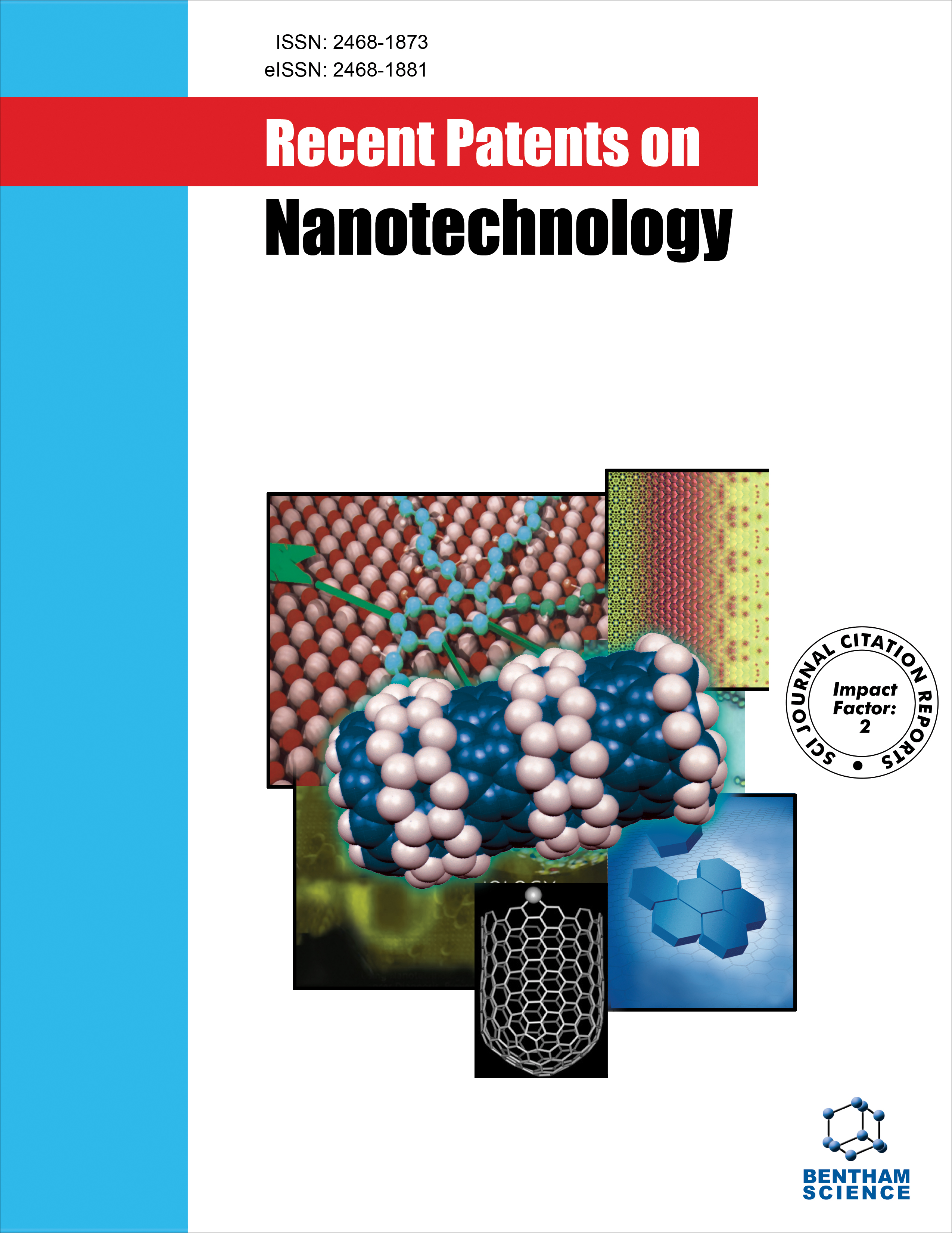- Home
- A-Z Publications
- Recent Patents on Nanotechnology
- Previous Issues
- Volume 17, Issue 1, 2023
Recent Patents on Nanotechnology - Volume 17, Issue 1, 2023
Volume 17, Issue 1, 2023
-
-
Polymeric Nanoparticles for the Treatment of Prostate Cancer- Technological Prospecting and Critical Analysis
More LessBackground: Polymeric nanoparticles have a wide diversity, and due to their toxicity and biodegradability, they have been widely used in the health area. Its use allows stability of some compounds, targeted delivery, and increased half-life, in this context, making some treatment proposals more effective. Prostate cancer, in turn, is among the types of cancer with the highest mortality, and the lack of effective treatment causes se Read More
-
-
-
Nanovaccine: A Hope to Triumph the Battle Against Novel Coronavirus Disease 2019 (COVID-19)
More LessAuthors: Anurag K. Singh, Anand Maurya, Gaurav Mishra, Rajendra Awasthi, Kamal Dua and Giriraj T. KulkarniBackground: The novel coronavirus 2019 (COVID-19) infection has caused the global emergence of coronavirus in humans during the last 12 months. Till May 11, 2021, the confirmed global COVID-19 cases and deaths reached 158551526 and 3296855, respectively. Methods: Goblet cells and ciliated cells in the nose act as the initial infection site of SARS-CoV-2. Thus, mucus immunity is important to protect from infection. Read More
-
-
-
Review on Different Vesicular Drug Delivery Systems (VDDSs) and Their Applications
More LessBackground: Colloidal dispersions, also known as vesicular drug delivery systems (VDDSs), are highly ordered assemblies composed of one or more concentric bilayers formed by the self-assembly of amphiphilic building blocks in the presence of water. Objective: VDDSs are important to target the entrapped drugs at specific sites inside the body, control the drug release, enhance the drug bioavailability, and reduce undesired si Read More
-
-
-
Recent Patents and Potential Applications of Homogenisation Techniques in Drug Delivery Systems
More LessAuthors: Harpreet K. Khanuja and Harish DurejaBackground: The term homogenise means "to force or provide coalesce". Homogenisation is a process to attain homogenous particle size. The objective of the homogenisation process is to use fluid force to split the fragments or tiny particles contained in the fluids into very small dimensions and form a sustainable dispersion suitable for further production. Methods: The databases were collected through Scopus, g Read More
-
-
-
Effect of Polyvinylpyrrolidone on Polyvinylidene Fluoride/Hydroxyapatite- Blended Nanofiltration Membranes: Characterization and Filtration Properties
More LessAuthors: Gunawan S. Prihandana, Tutik Sriani and Muslim MahardikaIntroduction: The application of polyvinylidene fluoride (PVDF) as a filtration membrane is limited due to its hydrophobicity. This paper elaborated on the fabrication process of nanofiltration PVDF membrane incorporating various quantities of hydrophilic polyvinylpyrrolidone (PVP) and hydroxyapatite (HA) using a wet phase inversion method to improve its hydrophilicity. Methods: The membrane was fabricated by using Read More
-
-
-
Eco-Friendly Intracellular Biosynthesis of CdS Quantum Dots Using Pseudomonas aeruginosa: Evaluation of Antimicrobial Effects and DNA Cleavage Activities
More LessAuthors: Necip Öcal, Ahmet Ceylan and Fatih DumanBackground: Intracellular biosynthesis of Quantum Dots (QDs) based on microorganisms offers a green alternative and eco-friendly for the production of nanocrystals with superior properties. This study focused on the production of intracellular CdS QDs by stimulating the detoxification metabolism of Pseudomonas aeruginosa. Methods: For this aim, Pseudomonas aeruginosa ATCC 27853 strain was incubated in a solutio Read More
-
-
-
Green Synthesis of Silver Nanoparticles Using Datura metel Flower Extract Assisted by Ultrasound Method and Its Antibacterial Activity
More LessAuthors: Is Fatimah, Habibi Hidayat, Bambang Nugroho and Saddam HuseinBackground: Green synthesis method of nanoparticles has been developed for several years. Besides providing environmental-friendly process, green synthesis of nanoparticles using plant extract provides synergistic effect of the secondary metabolite in such antibiotic activity. The study with an intensification process in nanoparticles formation is also gaining great attention. This research deals with the green synthesis of silver Read More
-
-
-
Enhanced Anti-Proliferative Effect of Carboplatin in Ovarian Cancer Cells Exploiting Chitosan-Poly (Lactic Glycolic Acid) Nanoparticles
More LessAuthors: Fatima R. Alassaif, Eman Redah Alassaif, Amit Kumar Kaushik and Jeevitha DhanapalObjective: The present article aimed to enhance the therapeutic efficacy of carboplatin (CP) using the formulation of chitosan-poly (lactic glycolic acid) nanoparticles (CS-PLGA NPs). Methods: Nanoparticles were synthesized by an ionic gelation method and were characterized for their morphology, particle size, and surface potential measurements by TEM and zeta sizer. This study was highlighted for the evaluation of d Read More
-
Volumes & issues
-
Volume 19 (2025)
-
Volume 18 (2024)
-
Volume 17 (2023)
-
Volume 16 (2022)
-
Volume 15 (2021)
-
Volume 14 (2020)
-
Volume 13 (2019)
-
Volume 12 (2018)
-
Volume 11 (2017)
-
Volume 10 (2016)
-
Volume 9 (2015)
-
Volume 8 (2014)
-
Volume 7 (2013)
-
Volume 6 (2012)
-
Volume 5 (2011)
-
Volume 4 (2010)
-
Volume 3 (2009)
-
Volume 2 (2008)
-
Volume 1 (2007)
Most Read This Month
Article
content/journals/nanotec
Journal
10
5
false
en


